You saw the first image of a black hole. Now see it better with AI.
Mix general relativity with machine learning, and an astronomical donut starts to look more like a Cheerio.

Astronomy sheds light on the far-off, intangible phenomena that shape our universe and everything outside it. Artificial intelligence sifts through tiny, mundane details to help us process important patterns. Put the two together, and you can tackle almost any scientific conundrum—like determining the relative shape of a black hole.
The Event Horizon Telescope (a network of eight radio observatories placed strategically around the globe) originally captured the first image of a black hole in 2017 in the Messier 87 galaxy. After processing and compressing more than five terabytes of data, the team released a hazy shot in 2019, prompting people to joke that it was actually a fiery donut or a screenshot from Lord of the Rings. At the time, researchers conceded that the image could be improved with more fine-tuned observations or algorithms.
[Related: How AI can make galactic telescope images ‘sharper’]
In a study published on April 13 in The Astrophysical Journal Letters, physicists from four US institutions used AI to sharpen the iconic image. This group fed the observatories’ raw interferometry data into an algorithm to produce a sharper, more accurate depiction of the black hole. The AI they used, called PRIMO, is an automated analysis tool that reconstructs visual data at higher resolutions to study gravity, the human genome, and more. In this case, the authors trained the neural network with simulations of accreting black holes—a mass-sucking process that produces thermal energy and radiation. They also relied on a mathematical technique called Fourier transform to turn energy frequencies, signals, and other artifacts into information the eye can see.
Their edited image shows a thinner “event horizon,” the glowing circle formed when light and accreted gas crosses into the gravitational sink. This could have “important implications for measuring the mass of the central black hole in M87 based on the EHT images,” the paper states.

One thing’s for sure: The subject at the center of the shot is extremely dark, potent, and powerful. It’s even more clearly defined in the AI-enhanced version, backing up the claim that the supermassive black hole is up to 6.5 billion times heftier than our sun. Compare that to Sagittarius A*—the black hole that was recently captured in the Milky Way—which is estimated at 4 million times the sun’s mass.
Sagittarius A* could be another PRIMO target, Lia Medeiros, lead study author and astrophysicist at the Institute for Advanced Study, told the Associated Press. But the group is not in a rush to move on from the more distant black hole located 55 million light-years away in Messier 87. “It feels like we’re really seeing it for the first time,” she added in the AP interview. The image was a feat of astronomy, and now, people can gaze on it with more clarity.
Watch an interview where the researchers discuss their AI methods more in-depth below:
